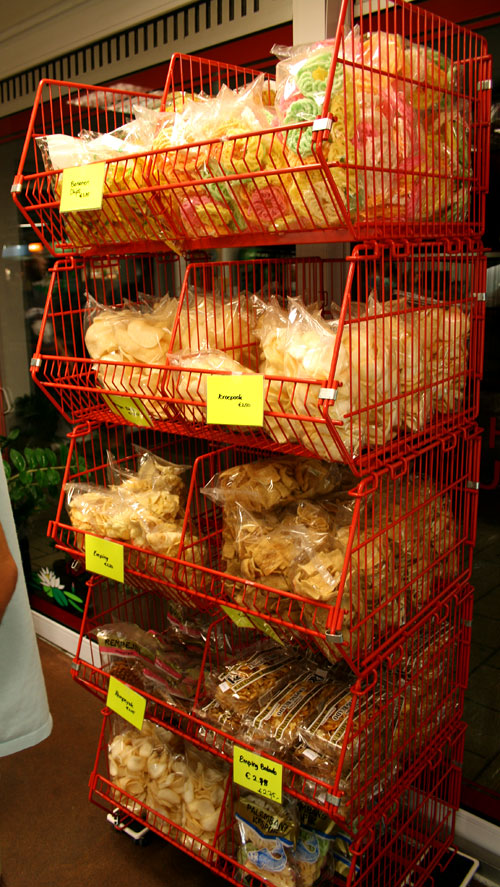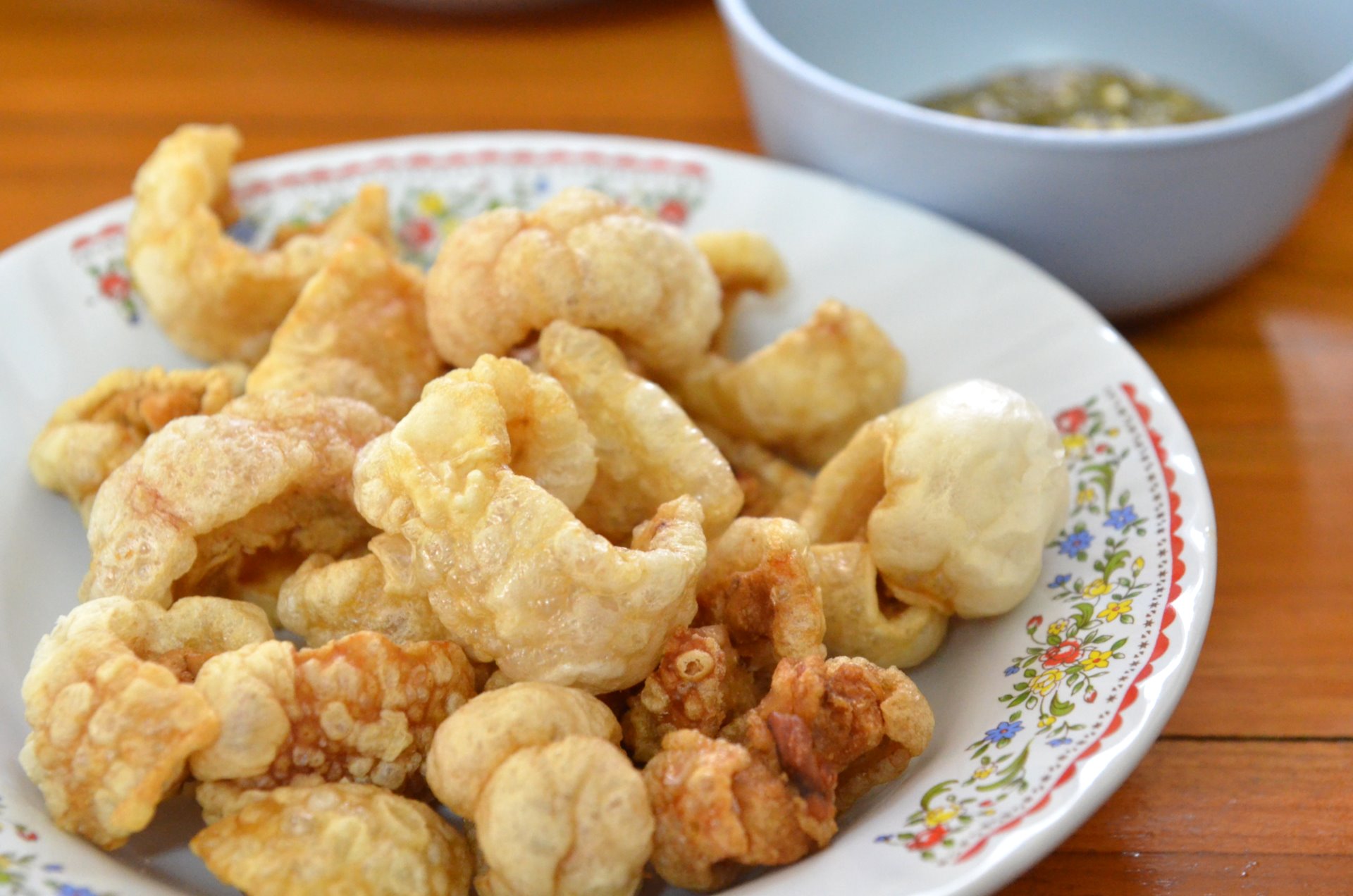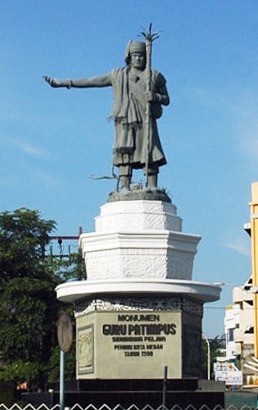|
Krupuk Kulit
Krupuk kulit ( jv, rambak or min, karupuak jangek, lit: "skin crackers") is a traditional Indonesian cattle skin ''krupuk'' (cracker). Traditionally it is made from the soft inner skin of cattle (cow or water buffalo), diced, and sun-dried until it hardens and loses most of its water content. The diced and dried skin are later fried in ample hot cooking oil until they expand in similar fashion with bubble and yield a crispy texture. This fried cattle skin is then sealed in vacuum plastic bags to ensure and prolong its crispiness. History ''Krupuk rambak'' or krupuk made from cow or buffalo skin, is the oldest-mentioned krupuk variant in ancient Java. According to a culinary historian, krupuk has been around in Java since the 9th or 10th century, written on the Batu Pura inscription as ''krupuk rambak,'' which still exists today in Javanese cuisine, usually in ''krechek'', a spicy stew. Serving Krupuk kulit is often served as a crispy snack to accompany main meals. In Padang r ... [...More Info...] [...Related Items...] OR: [Wikipedia] [Google] [Baidu] |
Indonesia
Indonesia, officially the Republic of Indonesia, is a country in Southeast Asia and Oceania between the Indian and Pacific oceans. It consists of over 17,000 islands, including Sumatra, Java, Sulawesi, and parts of Borneo and New Guinea. Indonesia is the world's largest archipelagic state and the 14th-largest country by area, at . With over 275 million people, Indonesia is the world's fourth-most populous country and the most populous Muslim-majority country. Java, the world's most populous island, is home to more than half of the country's population. Indonesia is a presidential republic with an elected legislature. It has 38 provinces, of which nine have special status. The country's capital, Jakarta, is the world's second-most populous urban area. Indonesia shares land borders with Papua New Guinea, East Timor, and the eastern part of Malaysia, as well as maritime borders with Singapore, Vietnam, Thailand, the Philippines, Australia, Palau, and India ... [...More Info...] [...Related Items...] OR: [Wikipedia] [Google] [Baidu] |
Batak (Indonesia)
Batak is a collective term used to identify a number of closely related Austronesian ethnic groups predominantly found in North Sumatra, Indonesia, who speak Batak languages. The term is used to include the Karo, Pakpak, Simalungun, Toba, Angkola, and Mandailing which are related groups with distinct languages and traditional customs (''adat''). Prehistory Linguistic and archaeological evidence indicates that Austronesian speakers first reached Sumatra from Taiwan and the Philippines through Borneo or Java about 2,500 years ago, and the Batak probably descended from these settlers. While the archaeology of southern Sumatra testifies to the existence of neolithic settlers, it seems that the northern part of Sumatra was settled by agriculturalists at a considerably later stage. Although the Batak are often considered to be isolated peoples thanks to their location inland, away from the influence of seafaring European colonials, there is evidence that they have been inv ... [...More Info...] [...Related Items...] OR: [Wikipedia] [Google] [Baidu] |
Padang Cuisine
Padang food or Minang food is the cuisine of the Minangkabau people of West Sumatra, Indonesia. It is among the most popular cuisines in Maritime Southeast Asia. It is known across Indonesia as ''Masakan Padang'' (Padang cuisine, in English usually the simpler Padang food) after Padang, the capital city of Western Sumatra province. It is served in restaurants mostly owned by ''perantauan'' (migrating) Minangkabau people in Indonesian cities. Padang food is ubiquitous in Indonesian cities and is popular in neighboring Malaysia and Singapore. Padang food is famous for its use of coconut milk and spicy chili. Minang cuisine consists of three main elements: '' gulai'' (curry), ''lado'' (chili pepper) and ''bareh'' (rice). Among the cooking traditions in Indonesian cuisine, Minangkabau cuisine and most of Sumatran cuisine demonstrate Indian and Middle Eastern influences, with dishes cooked in curry sauce with coconut milk and the heavy use of spice mixtures. Because most Minangka ... [...More Info...] [...Related Items...] OR: [Wikipedia] [Google] [Baidu] |
Krupuk
''Krupuk'' ( Javanese), ''kerupuk'' ( Indonesian), ''keropok'' ( Malay), ''kroepoek'' ( Dutch) or ''kropek'' (Tagalog) is a cracker made from starch or animal skin and other ingredients that serve as flavouring. Most krupuk are deep fried, while some others are grilled or hot sand fried. They are a popular snack in maritime Southeast Asia (Indonesia, Singapore, Malaysia, Brunei, and Philippines), and is most closely associated with the culinary traditions of Indonesia, in particular Javanese cuisine. It is an ubiquitous staple in its country of origin, and has spread to other countries either via the migration of diaspora populations or exports. Etymology ''Krupuk'' in Javanese means "fried side dish" (made of flour, mixed with other ingredients). The word was later absorbed to other languages and stylesized according to local pronunciations. In Indonesia and the modern states of Brunei, Malaysia, Singapore, and the Philippines, it appears under a general name with mi ... [...More Info...] [...Related Items...] OR: [Wikipedia] [Google] [Baidu] |
Prawn Cracker
Prawn crackers ( id, krupuk udang) are a deep fried snack made from starch and prawn. They are a common snack food in Southeast Asian cuisine, but they are most closely associated with Indonesia.They have also been adapted into East Asian cuisines. where the similar Japanese kappa ebisen () (Japan) and Korean saeukkang (Korea) are popular snacks. History According to the culinary historian Fadly Rahman, ''krupuk'' (crackers) have been around in Java since the 9th or 10th century. The Batu Pura inscription mentions ''krupuk rambak'', which are crackers made from cow or buffalo skin, that still exist today as '' krupuk kulit'', and are usually used in the Javanese dish ''krechek''. Krupuk spread across the archipelago, with varying ingredients, notably fish and prawn. From Java, krupuk spread to coastal areas of Kalimantan, Sumatra, to the Malay Peninsula. The coastal peoples of Kalimantan and Sumatera later developed ''krupuk'' made of prawn and fish to make use of leftov ... [...More Info...] [...Related Items...] OR: [Wikipedia] [Google] [Baidu] |
Pork Rinds
Pork rind is the culinary term for the skin of a pig. It can be used in many different ways. It can be rendered, fried in fat, baked, or roasted to produce a kind of pork cracklings (US) or scratchings (UK); these are served in small pieces as a snack or side dish. The frying renders much of the fat, making it much smaller. Snack Often a byproduct of the rendering of lard, it is also a way of making even the tough skin of a pig edible. In many ancient cultures, animal fats were the only way of obtaining oil for cooking and they were common in many people's diets until the industrial revolution made vegetable oils more common and more affordable. Microwaveable pork rinds are sold in bags that resemble microwaveable popcorn and can be eaten still warm. Pickled pork rinds, though, are often enjoyed refrigerated and cold. Unlike the crisp and fluffy texture of fried pork rinds, pickled pork rinds are very rich and buttery, much like ''foie gras''. Preparation For the la ... [...More Info...] [...Related Items...] OR: [Wikipedia] [Google] [Baidu] |
Chicharrón
(, , plural ; pt, torresmo ; fil, chicharon; ch, chachalon) is a dish generally consisting of fried pork belly or fried pork rinds. may also be made from chicken, mutton or beef. Name , as a dish with sauce, or as finger-food snacks, are popular in Andalusia and Canarias in Spain, Latin America and other places with Spanish influence including the Southwestern United States. It is part of the traditional cuisines of Bolivia, Brazil, Portugal (where it is called ), Chile, Colombia, Costa Rica, Cuba, the Dominican Republic, Ecuador, Guam, Guatemala, Haiti, Honduras, El Salvador, Mexico, Nicaragua, Panama, Peru, the Philippines, Puerto Rico, Venezuela, Belize and others. The singular form of the term or a variant of it is also used as a mass noun in Filipino and Tagalog, in which stand-alone plurals do not exist. are usually made from various cuts of pork but sometimes with mutton, chicken or other meats. In some places they are made from pork ribs ... [...More Info...] [...Related Items...] OR: [Wikipedia] [Google] [Baidu] |
Frog
A frog is any member of a diverse and largely carnivorous group of short-bodied, tailless amphibians composing the order Anura (ανοὐρά, literally ''without tail'' in Ancient Greek). The oldest fossil "proto-frog" ''Triadobatrachus'' is known from the Early Triassic of Madagascar, but molecular clock dating suggests their split from other amphibians may extend further back to the Permian, 265 million years ago. Frogs are widely distributed, ranging from the tropics to subarctic regions, but the greatest concentration of species diversity is in tropical rainforest. Frogs account for around 88% of extant amphibian species. They are also one of the five most diverse vertebrate orders. Warty frog species tend to be called toads, but the distinction between frogs and toads is informal, not from taxonomy or evolutionary history. An adult frog has a stout body, protruding eyes, anteriorly-attached tongue, limbs folded underneath, and no tail (the tail of tailed frogs is an ext ... [...More Info...] [...Related Items...] OR: [Wikipedia] [Google] [Baidu] |
Pork Rind
Pork rind is the culinary term for the skin of a pig. It can be used in many different ways. It can be rendered, fried in fat, baked, or roasted to produce a kind of pork cracklings (US) or scratchings (UK); these are served in small pieces as a snack or side dish. The frying renders much of the fat, making it much smaller. Snack Often a byproduct of the rendering of lard, it is also a way of making even the tough skin of a pig edible. In many ancient cultures, animal fats were the only way of obtaining oil for cooking and they were common in many people's diets until the industrial revolution made vegetable oils more common and more affordable. Microwaveable pork rinds are sold in bags that resemble microwaveable popcorn and can be eaten still warm. Pickled pork rinds, though, are often enjoyed refrigerated and cold. Unlike the crisp and fluffy texture of fried pork rinds, pickled pork rinds are very rich and buttery, much like '' foie gras''. Preparation For the ... [...More Info...] [...Related Items...] OR: [Wikipedia] [Google] [Baidu] |
Pork
Pork is the culinary name for the meat of the domestic pig (''Sus domesticus''). It is the most commonly consumed meat worldwide, with evidence of pig husbandry dating back to 5000 BCE. Pork is eaten both freshly cooked and preserved; curing extends the shelf life of pork products. Ham, gammon, bacon, and sausage are examples of preserved pork. Charcuterie is the branch of cooking devoted to prepared meat products, many from pork. Pork is the most popular meat in the Western world, particularly in Central Europe. It is also very popular in East and Southeast Asia ( Mainland Southeast Asia, Philippines, Singapore, and East Timor). The meat is highly prized in Asian cuisines, especially in Mainland China, for its fat content and texture. Some religions and cultures prohibit pork consumption, notably Islam and Judaism. History Pigs were domesticated in Mesopotamia around 13,000 BC. Charcuterie is the branch of cooking devoted to prepared meat products such ... [...More Info...] [...Related Items...] OR: [Wikipedia] [Google] [Baidu] |
Medan
Medan (; English: ) is the capital and largest city of the Indonesian province of North Sumatra, as well as a regional hub and financial centre of Sumatra. According to the National Development Planning Agency, Medan is one of the four main central cities of Indonesia, alongside Jakarta, Surabaya, and Makassar. As of the 2020 Census, Medan has a population of 2,435,252 within its city limits,Badan Pusat Statistik, Jakarta, 2021. and over 3.4 million in its built-up urban area, making it the fourth largest urban area in Indonesia. The Medan metropolitan area—which includes neighbouring Binjai, Deli Serdang Regency, and a part of Karo Regency—is the largest metropolitan area outside of Java, with 4,744,323 residents counted in the 2020 Census. Medan is a multicultural metropolis and a busy trading city bordered by the Strait of Malacca, making it one of the major economic cities in Indonesia. A gateway to the western part of Indonesia, Medan is supported by the ... [...More Info...] [...Related Items...] OR: [Wikipedia] [Google] [Baidu] |





_Ranomafana.jpg)


